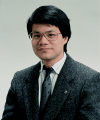 / Shunji Mori / Professor
/ Shunji Mori / Professor
 / Tony Y.T. Chan / Assistant Professor
/ Tony Y.T. Chan / Assistant Professor
 / Yu Nakajima / Research Associate
/ Yu Nakajima / Research Associate



 / Shunji Mori / Professor
/ Shunji Mori / Professor
 / Tony Y.T. Chan / Assistant Professor
/ Tony Y.T. Chan / Assistant Professor
 / Yu Nakajima / Research Associate
/ Yu Nakajima / Research Associate
First and foremost, the Image Processing Laboratory engages in research and development of image pattern recognition systems. More specifically, as can be seen from the background information and the recent research publications of the members of the laboratory, character recognition is our current focus. Related to the recent involvement of multimedia systems, character recognition has been noted by many researchers and engineers. On the other hand, character recognition techniques are generally divided into off-line and on-line methods. The former is typical in character recognition and aims at duplicating the human ability in recognition. However, on-line character recognition is also noted recently in connection with so-called pen computers. On-line methods provide very flexible, convenient, and natural human-interface. Historically speaking, these techniques have been developed separately. However, both techniques can be developed together in principle. The common approach makes possible recognition flexibility in such a way that the usual constraints being imposed on the on-line techniques can be removed. For example, writing order and number of stokes constituting a character are typical of such constraints. On the other hand, we are requested to develop an inspection system for flaw of Sake bottles. The contribution to the domestic industry is very important mission of our University. Therefore, we are doing a basic research on that together with Industry Application Laboratory. In general, image inspection is a very important theme and has many applications in industry broadly. Prof.Mori and Mr.Nakajima have engineering background. Actually, Prof.Mori was a leader of an OCR group when he worked for Ricoh Research and Development Center and developed a very powerful OCR package which is used in practice. One of the members of the OCR group was Mr. Nakajima, who has joined us as a research associate. He is well-acquainted with different computer systems and also works as an instructor in programming. The system developed is called filtering in character recognition, which makes the packages very fast without being hardware-specific. The OCR group were awarded the Excellence in Programming Prize from the Ministry of Post and Telecommunications. The basic configuration of the system was proposed by Prof. Mori.
Naturally, the essential point of the developed system lies in the excellent algorithm of character recognition, which is based on an algebraic approach at shape description. This approach was investigated as basic research by Prof. Mori when he worked for the Electro-technical Laboratory of the Ministry of International Trade and Industry. Later the basic line was further developed, in theory and in practice, by Prof. Nishida. We think that is one of the most elegant theories in character recognition. Because of its theoretical richness and high-level abstraction, the very broad applications in shape recognition in general. It is applicable to both off-line and on-line character recognition systems, for example. Further extension of the theory is in the application of the recognition of three-dimensional bodies, in which a piece of the surfaces must be represented effectively in terms of pattern recognitions and global organization mechanism. In this regard, a set of primitive surfaces must be considered. Furthermore, in addition to basic recognition mechanisms in a bottom-up manner. rich knowledge concerning ``objects" must be naturally employed. Some knowledge representational methods developed in the field of artificial intelligence research are being considered. Assistant Professor Chan is investigating unifying pattern recognition and artificial intelligence approaches.
Refereed Journal Papers
There are many instances in which character shape of a class changes smoothly to that of another class. Although there are many ways of the change, the most delicate change is curvature feature. The paper treat this problem systematically in both theoretically and experimentally. Specifically some confusing pairs were constructed which are well known in the field of OCR, such as 2 to Z, Z to 2 and 4 to 9, 9 to 4. A series of samples generated using each model which change subtly were provided to conduct a psychological experiment. The results exhibit a monotone change of recognition rates from nearly 100% to 0% as the shape changes continuously. To imitate the humans' performance, feature of curvature was extracted based on continuous function representation based on Bezie's spline curve. Specifically two methods were tried from theoretical and engineering points of view and very successful results were obtained.
Refereed Proceeding Papers
Current status of postal number reading technology in Japan is introduced and examined. On-line Chinese characters reading products are also inspected. From these, some basic issues to be solved are described. Multiple classifier systems are discussed and words recognition systems are considered, based on which the importance of low level and feature level research is claimed referring at Gestalt psychology. The modeling of character variations is described and its importance is emphasized. Finally, a new approach is proposed on structural stability to make a theory of characters.
A general computational analytical model to tackle the difficult unsupervised parity problem is described. The model is based on some additions and modifications to Goldfarb's Evolving proposal so that the model is more elegant and able to handle the unsupervised case. It turns out that it is most instructive to treat, in essence, the supervised problem with noise as an unsupervised problem. We demonstrate the success of the new model on the benchmark parity problem by showing how the inductive agent successfully learns the weights in a dynamic manner that would allow it to distinguish between bit-strings of any lengths and unknown labels.


